The Story of Primitive Hall
According to an entry in an existing leather bound religious pamphlet of Joseph Pennock, the builder, Primitive Hall was started in the latter part of 1738. Joseph Pennock, who came from Tipperary County, Ireland, had acquired the property in 1703 by virtue of a purchase in 1683 by his maternal grandfather, George Collet, of grants totaling 5,000 acres signed by William Penn. George Collet was an English Quaker whose business in Ireland was the Tanning of hides and lived in a leased property, Killhouse Castle, near Clonmel, Tipperary County. The original tract of land in West Marlborough Township consisted of 1,250 acres of which Joseph Pennock, after subtracting an earlier gift of land to one of his sons, owned 700 acres in 1738. This remained intact at the time of his death in 1771.
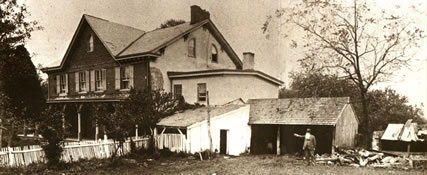
Joseph Pennock was married in 1705 to Mary, the daughter of Samuel Levis of French Huguenot extraction who had taken a prominent part in the early affairs of the Province of Pennsylvania and had served in 1692 as a member of the Governor's Council. They moved to West Marlborough Township before 1710 and it probably was then that a building, traditionally their first residence, was erected on the bank near the present road that evidently served later as one of the two flanking buildings when Mary and Joseph Pennock were able to move into their large new house, probably before 1740. The foundations of this 1710 building are still in existence below ground.
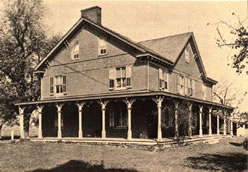
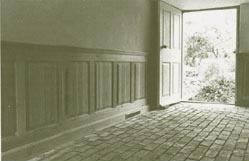
Joseph Pennock was active in the affairs of the Province, both in the Pennsylvania Assembly (Legislature) and as a Justice. He is described as having dignity combined with an engaging personality, good manners and hospitality.
The name "Primitive Hall" first appeared in any known record or in print, in a family tree published by Mrs. Casper W. Pennock, circa 1846 but must have been at least three generations older.
In 1825 what was unmistakably Primitive Hall is described as surrounded by tall evergreen trees, which gave us the suggestion of the forecourt hedge. The retaining walls of forecourt can be followed.
Although the house was changed many times, a careful study of existing traces including those of the original kitchen wing and of garden walls, should enable us to come extremely close to what was there during Joseph Pennock's lifetime. A farmhouse on part of the 700-acre tract and NW of Primitive Hall has in its oldest section, details similar to those found in Primitive Hall and part of the barn there may be contemporary. This suggests that the farming operations were conducted across the hill. All present barn foundations at Primitive Hall are comparatively recent. Joseph Pennock may have acquired his ideas of a handsome "country mansion" from his earlier years in Ireland.

Primitive Hall was an ambitious project and there is reason to believe that it required a number of years to finish. There is evidence in one bedroom that the wood work (mantelpiece and chair rail) never was completed.
The first building on the property, probably erected in or shortly after 1703, seems to have been the Spring House and used as a sort of stone cabin for overnight visits. This was in a dilapidated condition in 1920, and the only wall, which could be saved, is the western end facing the public road. However, in rebuilding the other three walls, the openings and even the remnant of a corner fireplace in the second story were reproduced.
The structure, which faces south, is 52' 2" wide at the front and 40' deep along the sides. Click here to view elevations. A unique adaptation of the William Penn town house plan (it is actually two Penn-plan houses connected by a center hall), the house is made up of four three-story brick sections, one in each corner of the building. All four sections are connected to the large center hall which runs from the south front of the house to the back. Each room has a corner fireplace, one of which is shown at right, in the process of restoration. The four west rooms – two up and two down – share a chimney, as do the four east rooms. There is a west cellar and an east cellar, but the earth beneath the brick-floored center hall is unexcavated. At the north end of the hall, which is constructed without a center arch, there is a wide open-well, closed-string staircase which rises from the first floor to the attic. The stairway balusters are finely turned from the first floor to the attic landing, but from the landing to the attic they are plainer – simple flat cross-sections of the lower turned balusters. Another generous feature of Primitive Hall is the number of large windows, most of which each contain 30 panes of glass in double sashes of 15 panes each.
Although much work was done to restore the exterior of Primitive Hall during the five decades from 1920 to 1970, restoration of the interior of the house began in earnest in January of 1973. With great care workmen preserved the house's original woodwork, replacing sections of wainscoting only where it had disappeared from the staircase wall, matching the design and character of the new wood to the original yellow pine and poplar woodwork.
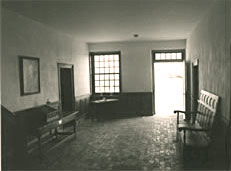
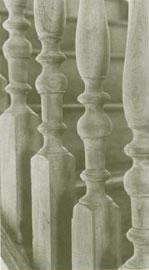
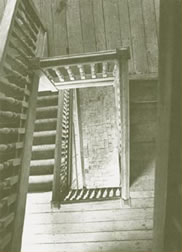

The walls were repainted with buttermilk-based paint that faithfully reproduces the effect of the original whitewash. The floors, their random planks worn and scarred, were renewed with scrub brushes, sandpaper and flax soap. Fireplace mantles and paneling, chair rails and wooden clothes pegs were restored in those rooms which had them originally.
Included among the house's furnishings are six-foot long paneled settle with a leather seat that can be opened to form a bed, a drop leaf oval table that is one of the largest to be found in the area, a wainscot armchair and side char, a slant top desk with magnificent interior detail, and a large storage chest.
The last of Joseph Pennock's descendants to own Primitive Hall was the late Stewart Huston, who in 1920 began the process of faithful restoration which spanned many decades. In 1960 the house and property were transferred to the Primitive Hall Foundation, which completed the restoration work in 1974 and whose members and Board of Trustees continue to maintain the building and its grounds as a historical monument for the benefit of the public.
Primitive Hall, whose interior had remained unfinished since 1738, was finally completed in 1976 – a fitting tribute to the Nation's Bicentennial.
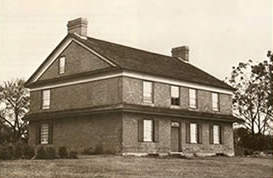
Historians, architects and many others who have come to know Primitive Hall consider it one of the lesser known but most important houses in Pennsylvania. Few buildings anywhere so faithfully retain their original character as Primitive Hall – not only the character of brick and mortar, but the sense of 18th Century solitude and strength.

